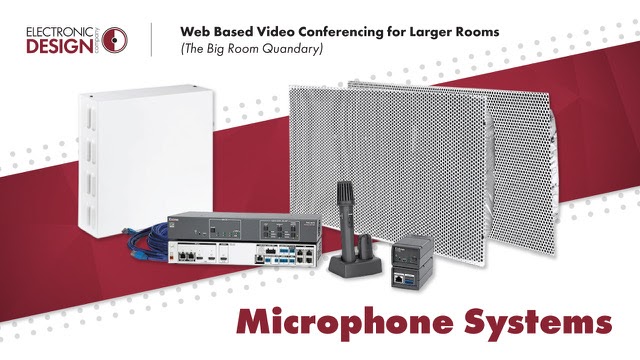
Web Based Video Conferencing for Larger Rooms (The Big Room Quandary): Microphone Systems
October 27, 2021In your typical online meeting, you sit down in front of an open laptop. The camera and a microphone are pretty close and pointed right at you. In fact, it’s about the best setup you can get – the other folks in the meeting can see and hear you fairly well. Now imagine setting that laptop at the end of long board room table or, even worse, at the front of a training room and trying to see and hear everyone in the room from just that little built-in microphone and camera. Anyone watching remotely would quickly get frustrated trying to figure out who was talking and what was being said. Unless you are willing to put a wireless lapel mic on every participant and have a dedicated sound engineer, like some kind of big Broadway production, there is no perfect solution. There is only a balance between practicalities and the audio quality for the far-end listener.
With the exception of a huddle space type scenario, where you can put a single microphone in the middle of a small hand full of people (which has its own issues) the solution usually involves multiple microphones and some speakers. These typically fall into two categories – conference rooms and training rooms. Although there are similarities between these there are also some subtle differences.
In a typical conference room, attendees sit around a table with a display of some sort at one end. Everyone tends to be fixed to a seat. Yes, every once in a while, you get the “roamer” who likes to get up and wander around the room while speaking. That’s another issue altogether. But for the most part there are a limited number of people that usually stay in one spot. This means you can put some microphones on (or in) the table, install them in the ceiling or – if the distance isn’t too much – have a microphone at the display with a specialized pattern for picking up more the people and less of the ambient noise around the room (more about this topic in a later installment). A discussion with the system designer will help weigh the costs and benefits of how much of the microphones are “seen” and how well they pick up the speaker. Better yet, have the designer be on a meeting to act as a “fly on the wall” in order to analyze a real-world scenario and offer an appropriate solution.
Training rooms have even more hurdles to jump when integrating remote attendees. There’s a single presenter that may wander between a podium and a big screen. Since there’s a room full of people, can more than one person speak at once? If there are multiple cameras, are they required to get up and walk over to a microphone in order to be seen by the far-end or are there many microphones placed around the room and the camera can move around and point to the speaker? As you can tell, things get complicated fast. At some point a person dedicated to running the live AV might be required where an automated system won’t cut it. And there’s another consideration. In a big room voices will need to be amplified over a sound reinforcement system in order to be clearly heard by everyone else. We will tackle that issue in a later installment.
In either of these cases there will be some kind of processing involved. Level adjustments will need to be made, audio sources mixed and the far-end attendees to hear.This takes us back to our previous installment talking about AEC (Acoustic Echo Cancellation) and the use of a DSP (Digital Signal Processor). This dedicated hardware can automate and control these functions where the software running the meeting just doesn’t have that capacity. Some microphone “aiming” can be achieved with the use of some newer technology ,the manufacturer puts many microphone capsules in an enclosure and manipulates the level and phase of each. Some are even made to look like a standard acoustic ceiling tile and blend nicely into the environment. But even with this newer technology simple physics always wins and a general rule of thumb holds true – the closer the microphone is to the source the less it will pick up everything else.
NEXT INSTALLMENT: Sound Reinforcement.


